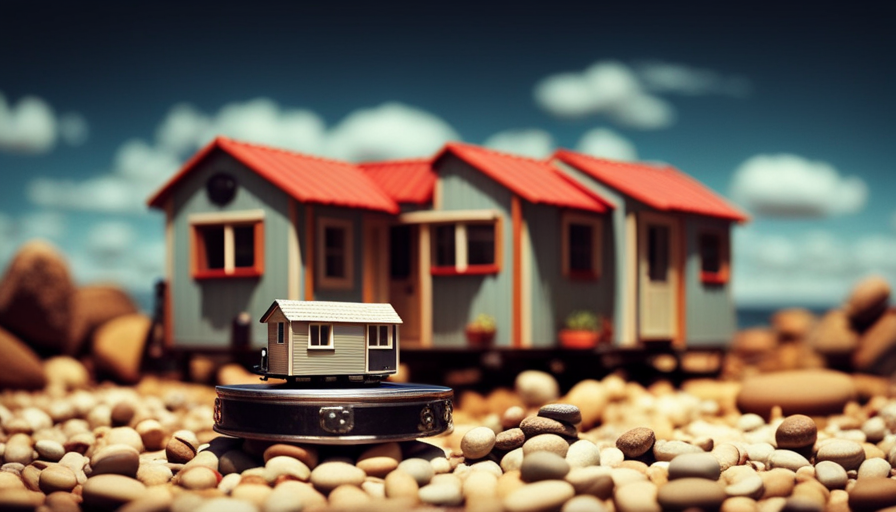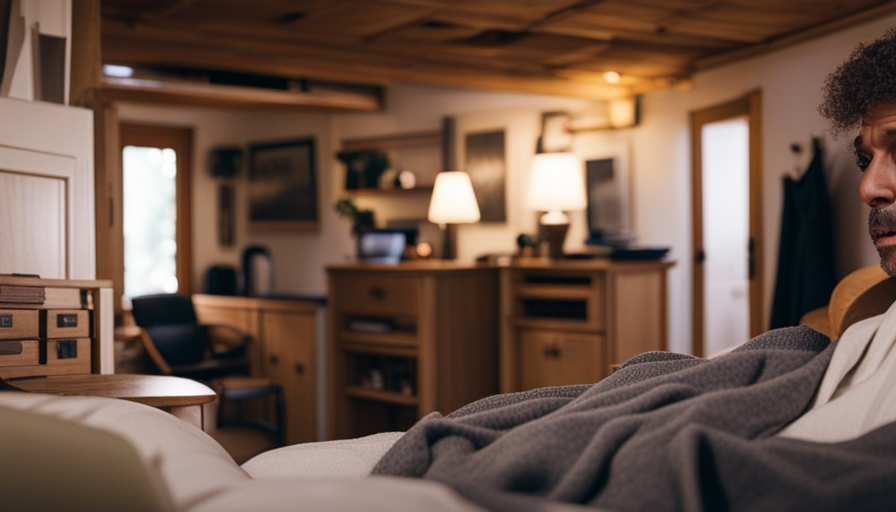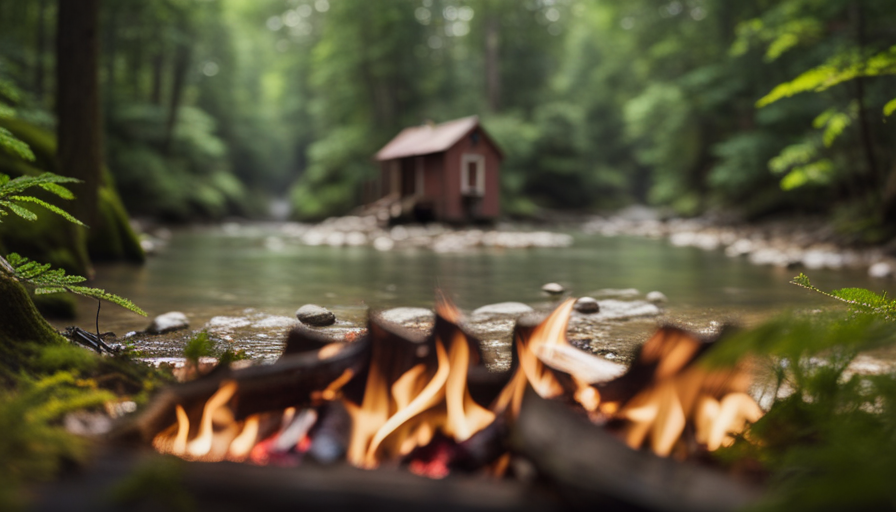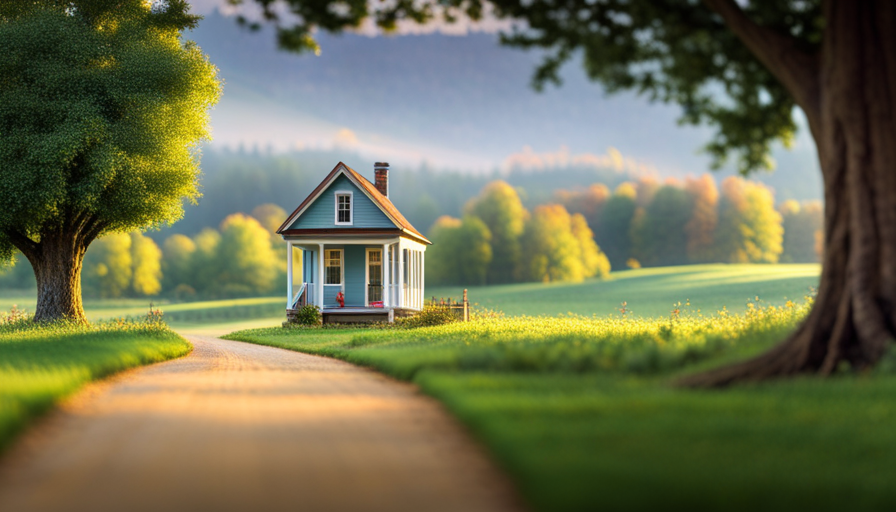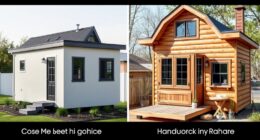Picture residing in a snug, environmentally sustainable abode tucked away in natural surroundings, where every inch is effectively used, and your impact on the environment is significantly reduced. This lifestyle is a reality for numerous individuals who have opted to adopt the tiny house movement.
Take, for example, Sarah, a young professional who decided to downsize her life and live in a 250-square-foot tiny house. With carefully designed spaces and innovative storage solutions, Sarah’s tiny house not only provides her with a comfortable living environment but also helps protect the planet.
Tiny houses offer a multitude of benefits for the environment. They promote efficient use of space, reducing energy consumption and waste. Their minimalist lifestyle encourages a lower carbon footprint, and many tiny houses are designed to be off-grid, relying on renewable energy sources.
Additionally, the tiny house movement fosters community building and provides an affordable housing option. By embracing sustainable development and inspiring a greener lifestyle, tiny houses play a vital role in creating a more environmentally conscious society.
Key Takeaways
- Tiny houses minimize environmental footprint and promote efficient use of space.
- They rely on renewable energy sources and can be designed to be off-grid.
- Tiny houses foster community building and provide affordable housing options.
- Living in a tiny house encourages a simpler lifestyle, reduced waste, and a closer connection with nature.
Efficient Use of Space
The use of smart design and innovative storage solutions in tiny houses allows for maximum efficiency in space utilization. Efficient organization and space-saving techniques are key factors in making the most out of limited square footage.
With careful planning and thoughtful design, every inch of a tiny house can be utilized effectively. One common space-saving technique is the use of multi-functional furniture, such as a sofa that can be transformed into a bed or a dining table that can be folded away when not in use. Additionally, utilizing vertical space through the use of built-in shelves and loft beds helps to maximize storage capacity.
Efficient use of space in tiny houses not only allows for more comfortable living but also contributes to the preservation of the environment. By minimizing square footage, tiny houses require fewer materials for construction, leading to reduced waste. Moreover, smaller spaces are easier to heat, cool, and maintain, resulting in reduced energy consumption. This not only saves money but also helps to minimize the carbon footprint.
By incorporating efficient organization and space-saving techniques, tiny houses offer a sustainable housing solution that promotes a greener lifestyle.
Reduced Energy Consumption
By living in a tiny house, you can significantly lower your energy consumption and create a more sustainable lifestyle. One way to achieve this is by using energy-efficient appliances. These appliances are designed to use less electricity or water while still providing the same level of functionality. For example, compact refrigerators and dishwashers consume less energy compared to their larger counterparts. By incorporating such appliances into your tiny house, you can reduce your overall energy usage.
In addition to using energy-efficient appliances, tiny houses can also take advantage of renewable energy sources. Installing solar panels on the roof of your tiny house can harness the power of the sun and generate electricity. This renewable energy can be used to power your appliances, lighting, and heating systems. By utilizing renewable energy sources, you can reduce your reliance on fossil fuels and decrease your carbon footprint.
To emphasize the benefits of reduced energy consumption and renewable energy, consider the following table:
| Benefits of Reduced Energy Consumption and Renewable Energy |
|---|
| Lower electricity bills |
| Reduced greenhouse gas emissions |
| Increased energy independence |
| Contribution to a more sustainable future |
Living in a tiny house allows you to lower your energy consumption through the use of energy-efficient appliances and renewable energy sources. This sustainable lifestyle choice not only benefits the environment but also offers financial savings and increased energy independence. Transitioning to a minimalist lifestyle further enhances these advantages.
Minimalist Lifestyle
Living a minimalist lifestyle in a tiny house is like stepping into a world of boundless freedom and uncluttered bliss. The minimalist design of a tiny house encourages simplicity and intentional living. With limited space, there is no room for unnecessary possessions. This forces us to carefully consider what we truly need and value.
The decluttering benefits of living in a tiny house are immense. By getting rid of excess belongings, we free up physical and mental space. This leads to reduced stress and a clearer mind.
Living in a tiny house also promotes a more sustainable way of life. With fewer possessions, we consume less and produce less waste. The small square footage of a tiny house requires less energy to heat and cool, resulting in lower energy consumption and reduced carbon emissions. Additionally, the compact size encourages us to live closer to nature and make use of outdoor spaces. This promotes a deeper connection with the environment and encourages eco-friendly practices such as gardening and composting.
Transitioning into the subsequent section about ‘lower carbon footprint’, we can see how living a minimalist lifestyle in a tiny house contributes to a lower carbon footprint. By consuming less and embracing simplicity, we’re able to lead a more sustainable and environmentally-conscious life.
Lower Carbon Footprint
Transitioning into a lower carbon footprint, I can imagine myself treading lightly on the Earth, leaving behind a trail of eco-friendly choices and sustainable practices. One such choice is embracing the tiny house movement.
Not only does living in a tiny house promote a minimalist lifestyle, but it also significantly reduces our environmental impact. One of the key ways that tiny houses help lower our carbon footprint is through their smaller size. With less square footage to heat or cool, tiny houses require less energy to maintain a comfortable living environment. This translates to lower utility bills and reduced emissions from power plants.
Additionally, the materials used to construct tiny houses often have a lower environmental impact. Many tiny house builders prioritize using recycled or sustainable materials, further reducing their carbon footprint.
Another significant advantage of tiny houses is their lower cost. Not only are they more affordable to build and maintain, but they also require fewer resources to create. This means less energy consumption and fewer materials extracted from the Earth. By opting for a smaller, more sustainable living space, we can minimize our environmental impact while also saving money.
Transitioning into off-grid living, we can explore even more ways to reduce our carbon footprint and embrace a self-sufficient lifestyle.
Off-Grid Living
Embracing the concept of off-grid living allows individuals to disconnect from traditional power sources and instead rely on renewable energy systems. Living off-grid in a tiny house promotes self-sufficiency and reduces our impact on the environment. By harnessing renewable energy sources such as solar panels or wind turbines, tiny house dwellers can generate their own electricity without relying on fossil fuels. This not only reduces carbon emissions but also decreases our dependence on non-renewable resources.
Off-grid living in a tiny house encourages a more sustainable lifestyle. With limited space, individuals are forced to be mindful of their energy consumption and make conscious choices to minimize waste. Tiny houses are often designed with energy-efficient features such as insulation, LED lighting, and composting toilets. These eco-friendly practices further contribute to reducing our carbon footprint.
Moreover, off-grid living fosters a deeper connection with nature. Being self-sufficient in terms of energy allows individuals to live in remote areas where traditional power sources are inaccessible. This immersion in nature promotes a greater appreciation for the environment and encourages sustainable practices beyond just energy consumption. By living off-grid in a tiny house, individuals can embrace a simpler, more sustainable way of life that benefits both themselves and the planet.
Moving on to the next section, let’s explore how tiny houses enhance our connection with nature.
Connection with Nature
Immersing yourself in off-grid living, have you ever wondered how a tiny house can deepen your connection with nature? Living in a tiny house allows you to be intimately connected with the natural environment surrounding you. With limited space, tiny houses often have large windows that provide panoramic views of the outdoors, allowing you to feel a constant connection with nature, even while inside.
This close proximity to the outdoors encourages you to spend more time outside, engaging in various outdoor activities. Living in a tiny house means you have the opportunity to explore and appreciate the natural world in a more meaningful way. You can easily step outside and take a hike through the woods, go for a swim in a nearby lake, or simply sit outside and enjoy the sights and sounds of nature.
The simplicity of tiny house living also encourages a slower pace of life, allowing you to fully immerse yourself in the beauty and tranquility of the natural world.
Transitioning into the subsequent section about ‘community building’, tiny house living not only connects you with nature but also fosters a strong sense of community.
Community Building
Living in a tiny house fosters close-knit communities as residents often have limited space and interact more with their neighbors. This promotes a sense of belonging and encourages social interaction.
Additionally, tiny house communities often embrace the concept of shared resources and collaborative living, where residents work together to reduce waste, share tools and equipment, and support each other in various aspects of daily life. This not only strengthens the community bond but also promotes sustainability and a more efficient use of resources.
Foster close-knit communities
Building tiny houses fosters close-knit communities, bringing people together in a cozy and sustainable way. These small dwellings encourage social connections and promote urban agriculture, creating a sense of belonging among neighbors. In a tiny house community, there is often a shared garden space where residents can grow their own food, fostering a connection to nature and promoting sustainable living. This not only reduces the carbon footprint but also encourages a healthier lifestyle. Additionally, the close proximity of tiny houses allows for frequent interactions and collaborations among neighbors, creating a strong support system and a sense of camaraderie. Sharing resources and collaborating on various projects become the norm, leading to a more sustainable and harmonious way of living. Transitioning into the subsequent section, shared resources and collaborative living further enhance the benefits of tiny house communities.
Shared resources and collaborative living
By pooling our resources and working together, residents of tiny house communities create a strong support system that promotes sustainability and enhances our overall quality of life. Collaborative living is not only beneficial but also essential for a thriving community.
In a shared economy, resource sharing is key. Here are three ways that tiny house communities embrace this concept:
-
Shared Utilities: By sharing water, electricity, and other utilities, we reduce our overall consumption and waste. This not only saves money but also reduces our environmental impact.
-
Shared Tools and Equipment: Instead of each household owning its own lawnmower or power tools, we have a communal toolshed where we can borrow and share equipment. This reduces the need for each household to purchase and maintain their own, saving money and reducing waste.
-
Shared Transportation: Many tiny house communities have a car-sharing program, where residents can use a shared vehicle for errands or trips. This reduces the number of cars on the road, decreases traffic congestion, and lowers carbon emissions.
By embracing a shared economy and resource sharing, tiny house communities are paving the way for a more sustainable future. This collaborative living model not only benefits the environment but also creates a stronger sense of community and belonging.
Transitioning into the next section, tiny houses also provide an affordable housing option for individuals and families.
Affordable Housing Option
One key aspect of tiny houses as an affordable housing option is the lower construction and maintenance costs. With a smaller footprint, the materials and labor required for building a tiny house are significantly reduced, making it a more cost-effective option. Additionally, the reduced size also means lower maintenance costs, as there’s less space to clean, repair, and maintain.
Another advantage of choosing a tiny house as an affordable housing option is the financial freedom it provides and the potential for reduced debt. With a smaller mortgage or even the possibility of owning the house outright, individuals can allocate more of their income towards other expenses or savings. This can lead to a greater sense of financial security and the ability to pursue other life goals without being burdened by excessive debt.
By offering a more affordable housing option, tiny houses can help individuals and families achieve greater financial stability and independence. With lower construction and maintenance costs, as well as the potential for reduced debt, tiny houses provide a practical solution for those seeking affordable housing without compromising on quality or comfort.
Lower construction and maintenance costs
Another benefit of tiny houses is that they have lower construction and maintenance costs, which can be a significant advantage for those looking to live a more sustainable lifestyle.
Tiny homes are designed to be efficient and use fewer resources during construction. They often incorporate eco-friendly construction techniques, such as using recycled materials or installing energy-efficient systems. These practices not only reduce the ecological impact of building a house but also contribute to a greener environment.
In addition, the smaller size of tiny homes means lower maintenance costs. With less space to clean and maintain, homeowners can save both time and money. These reduced costs make tiny houses an attractive option for those seeking financial freedom and reduced debt. By choosing a tiny house, individuals can embrace a more sustainable lifestyle while enjoying the benefits of lower construction and maintenance expenses.
Financial freedom and reduced debt
Living in a tiny home can be the key to unlocking a life free from the chains of financial burden and debt, paving the way towards a brighter and more prosperous future. The financial freedom that comes with owning a tiny house allows individuals to achieve financial independence and improve their quality of life.
With lower construction and maintenance costs, tiny homes provide an affordable housing option that significantly reduces monthly expenses. This enables homeowners to allocate their resources towards other important aspects of life, such as education, travel, or investment opportunities. By minimizing debt and living within one’s means, individuals can experience a sense of security and stability.
Moreover, the reduced financial stress and increased savings achieved through tiny house living can ultimately lead to a more sustainable and fulfilling lifestyle. Transitioning into encouraging sustainable development, tiny homes also promote environmental consciousness and resource efficiency.
Encouraging Sustainable Development
By promoting sustainable development, tiny houses offer an eco-friendly solution that reduces carbon footprint and fosters environmental conservation. These small dwellings are designed with sustainable architecture principles in mind, focusing on maximizing energy efficiency and minimizing waste.
Many tiny houses incorporate eco-friendly materials such as reclaimed wood or recycled materials for construction, further reducing their environmental impact. Additionally, these homes often utilize renewable energy sources, such as solar panels or wind turbines, to power their energy needs.
Living in a tiny house encourages eco-friendly living by necessitating a simpler lifestyle. With limited space, occupants are compelled to downsize and consume less, resulting in reduced waste and a smaller ecological footprint. Furthermore, the compact size of tiny houses promotes efficient land use, as they can be built on smaller plots of land, reducing urban sprawl and preserving natural habitats.
Tiny houses also have the potential to inspire a greener lifestyle beyond their own construction and operation. Their unique design and lifestyle choices can serve as a model for sustainable living, encouraging individuals and communities to adopt environmentally conscious practices. By embracing the principles of sustainable development, tiny houses not only provide affordable housing options and financial freedom but also contribute to a more environmentally conscious society.
Transitioning into the subsequent section about inspiring a greener lifestyle, tiny houses serve as a catalyst for positive change in our approach towards the environment.
Inspiring a Greener Lifestyle
Transitioning into the subsequent section about inspiring a greener lifestyle, tiny houses can serve as a catalyst for positive change in our approach towards the environment.
One of the ways in which tiny houses contribute to a greener lifestyle is by promoting greener transportation. With their compact size and lightweight design, tiny houses require less fuel to transport from one place to another compared to traditional houses. This not only reduces carbon emissions but also encourages people to rely more on sustainable modes of transportation such as biking or walking.
Additionally, tiny houses also encourage waste reduction. Due to their limited space, tiny house dwellers are forced to be more mindful of their consumption habits. They often prioritize quality over quantity and opt for sustainable and eco-friendly products. Furthermore, tiny house living promotes a simpler lifestyle, which means less accumulation of unnecessary belongings and less waste generated overall.
Furthermore, many tiny house owners embrace sustainable practices such as composting, rainwater harvesting, and utilizing renewable energy sources. These practices not only reduce their carbon footprint but also inspire others to adopt similar eco-friendly habits.
Tiny houses play a crucial role in inspiring a greener lifestyle. By promoting greener transportation and waste reduction, they encourage individuals to make conscious choices that have a positive impact on the environment.
Frequently Asked Questions
Are tiny houses suitable for families with children?
Tiny houses are absolutely suitable for families with children! While some may worry about the safety of living in a tiny house, the truth is that they’re designed with safety in mind. Plus, living in a tiny house can save families a significant amount of money on housing costs. Despite their small size, tiny houses can provide a comfortable and cozy living space for families, making them a great option for those looking to simplify their lives and reduce their environmental footprint.
How do tiny houses handle waste management, such as sewage and trash disposal?
In terms of waste management, tiny houses typically employ sustainable and eco-friendly practices. Many tiny houses incorporate composting toilets or dry flush toilets, which minimize water usage and do not require sewage treatment infrastructure.
Additionally, waste reduction is a key aspect of tiny house living. With limited space, residents are encouraged to reduce, reuse, and recycle, resulting in less overall waste production. These practices contribute to a more sustainable and environmentally friendly lifestyle.
Can tiny houses be relocated easily?
Relocating tiny houses is a breeze! They offer unparalleled mobility options, making them a dream for those seeking a nomadic lifestyle. However, there are some relocation challenges to consider. Moving a tiny house requires proper planning, permits, and a suitable mode of transportation. Despite these hurdles, the ability to easily transport a tiny house allows for flexibility and freedom.
Now, let’s delve into how tiny houses help the environment.
What are the zoning regulations and legal considerations for living in a tiny house?
Zoning regulations and legal considerations are important factors to consider when living in a tiny house.
Zoning regulations vary by location and may determine where you can park or build your tiny house. It’s crucial to check local codes and ordinances to ensure compliance.
Legal considerations include obtaining necessary permits and licenses, as well as adhering to building codes and safety standards. Consulting with local authorities and professionals can help navigate these regulations and ensure a legal and compliant living arrangement.
Do tiny houses require special insurance coverage?
Yes, tiny houses do require special insurance coverage. Due to their unique nature and potential for mobility, traditional homeowners insurance may not provide adequate protection. Specialized tiny house insurance policies are available that cover both the structure and personal belongings. These policies typically include liability coverage as well. It’s important to ensure you have the right coverage to protect your investment. Additionally, the relocation feasibility of tiny houses allows for flexibility in choosing the best insurance options for your specific needs.
Conclusion
In conclusion, embracing the tiny house movement is a harmonious dance with nature. Like a graceful river, tiny houses efficiently use space, reducing energy consumption and leaving a smaller carbon footprint.
They inspire a greener lifestyle, encouraging sustainable development and off-grid living. With their minimalist charm, these humble abodes foster community building and offer an affordable housing option.
Let us join this eco-conscious revolution, where the melody of tiny houses harmonizes with the symphony of a greener world.
Hi, I’m Emma. I’m the Editor in Chief of Tiny House 43, a blog all about tiny houses. While tree houses are often associated with childhood, they can be the perfect adult retreat. They offer a cozy space to relax and unwind, surrounded by nature. And since they’re typically built on stilts or raised platforms, they offer stunning views that traditional homes simply can’t match. If you’re looking for a unique and romantic getaway, a tree house tiny house might just be the perfect option.

